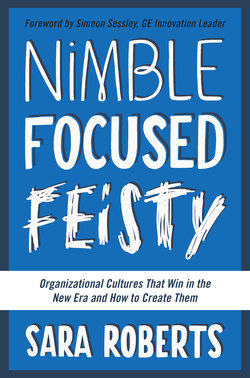Читать книгу Nimble, Focused, Feisty - Сара Робертс - Страница 7
ОглавлениеHOW DO TWENTIETH-CENTURY COMPANIES become nimble, focused, and feisty? That’s a question Sara Roberts asks and answers in this book, and it’s a problem I grappled with firsthand while leading a coaching community as Innovation Leader at GE.
In 2013, I initially thought the challenge of rolling out an organization-wide innovation methodology through a large group of willing and eager team members would be relatively straightforward. We had a bevy of supportive tools and templates at our disposal and a century of confidence in the company’s track record of reinvention. Yet, we encountered the sort of widespread and subconscious resistance to change that brings to mind Peter Drucker’s famous observation that “Culture eats strategy for lunch.”
My role was to get several hundred internal coaches aligned around that strategy and equip them to lead their teams through new external offerings and internal processes. I soon discovered that I could not simply rely on templates and methodology to make this happen; there were other, unspoken barriers in the mindset of the coaching team holding us back. Essentially, we were running into an invisible fence called culture. Sara and her group helped make that invisible fence far more visible.
What did that fence look like? Occasionally, for example, we encountered well-intentioned but sometimes over-engineered and limiting processes that hampered our coaches who were trying to guide their teams to think outside the box within volatile markets. We also needed people to take ownership of total outcomes and give up the luxury of being able to say, “I executed on and was in compliance with what that other team told me, so it’s not my fault if we didn’t hit the mark.”
Exposing such mindsets and getting people to be honest with themselves was difficult and even emotional work. More than once I heard a leader say, “I didn’t come here to think about me; just give me what I need to help me drive my people.” Yet self-awareness and a conscious decision to change mindsets and behaviors is what it takes, we found, to go beyond the current paradigm and understand what kind of culture is necessary at GE for coaches to drive innovation.
Sometimes that honesty provoked hard questions, such as, “Am I the right coach or leader to see this change through?” It’s also easy to drift back to familiar comfort zones and risk becoming the kind of manager each of us quietly despises. Sara helped us understand the premise of personal change as a means to culture change, as well as the possibility that we needed more heterogeneity in the people we selected. A mix of personality types and outlooks was important in creating a team of early adopters capable of taking on large-scale organizational change.
We were motivated by the discovery that we were being chartered for a higher purpose than just refashioning internal processes to reap market benefits. Our job was to be courageous leaders able to pivot toward fresh ideas and leverage opportunities for our employees to “play big,” deliver more, and have the license to do something amazing. To get there, we needed to implement the roots of a new culture—something that you, the readers of this book, will now have the opportunity to learn how to do.
Simeon Sessley, Innovation Leader, GE
